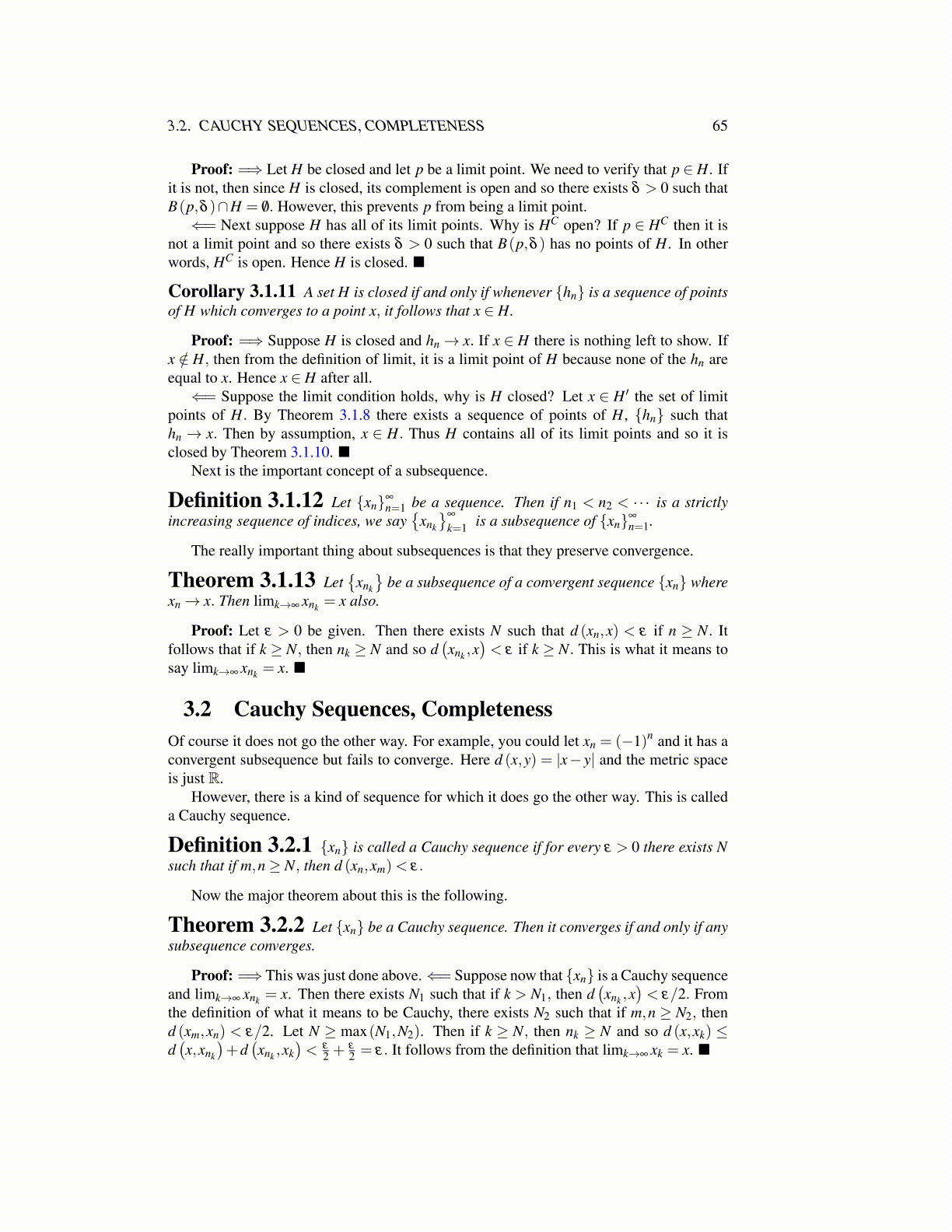
3.2. CAUCHY SEQUENCES, COMPLETENESS 65
Proof: =⇒ Let H be closed and let p be a limit point. We need to verify that p ∈ H. Ifit is not, then since H is closed, its complement is open and so there exists δ > 0 such thatB(p,δ )∩H = /0. However, this prevents p from being a limit point.⇐= Next suppose H has all of its limit points. Why is HC open? If p ∈ HC then it is
not a limit point and so there exists δ > 0 such that B(p,δ ) has no points of H. In otherwords, HC is open. Hence H is closed. ■
Corollary 3.1.11 A set H is closed if and only if whenever {hn} is a sequence of pointsof H which converges to a point x, it follows that x ∈ H.
Proof: =⇒ Suppose H is closed and hn→ x. If x ∈ H there is nothing left to show. Ifx /∈ H, then from the definition of limit, it is a limit point of H because none of the hn areequal to x. Hence x ∈ H after all.⇐= Suppose the limit condition holds, why is H closed? Let x ∈ H ′ the set of limit
points of H. By Theorem 3.1.8 there exists a sequence of points of H, {hn} such thathn → x. Then by assumption, x ∈ H. Thus H contains all of its limit points and so it isclosed by Theorem 3.1.10. ■
Next is the important concept of a subsequence.
Definition 3.1.12 Let {xn}∞
n=1 be a sequence. Then if n1 < n2 < · · · is a strictlyincreasing sequence of indices, we say
{xnk
}∞
k=1 is a subsequence of {xn}∞
n=1.
The really important thing about subsequences is that they preserve convergence.
Theorem 3.1.13 Let{
xnk
}be a subsequence of a convergent sequence {xn} where
xn→ x. Then limk→∞ xnk = x also.
Proof: Let ε > 0 be given. Then there exists N such that d (xn,x) < ε if n ≥ N. Itfollows that if k ≥ N, then nk ≥ N and so d
(xnk ,x
)< ε if k ≥ N. This is what it means to
say limk→∞ xnk = x. ■
3.2 Cauchy Sequences, CompletenessOf course it does not go the other way. For example, you could let xn = (−1)n and it has aconvergent subsequence but fails to converge. Here d (x,y) = |x− y| and the metric spaceis just R.
However, there is a kind of sequence for which it does go the other way. This is calleda Cauchy sequence.
Definition 3.2.1 {xn} is called a Cauchy sequence if for every ε > 0 there exists Nsuch that if m,n≥ N, then d (xn,xm)< ε.
Now the major theorem about this is the following.
Theorem 3.2.2 Let {xn} be a Cauchy sequence. Then it converges if and only if anysubsequence converges.
Proof: =⇒ This was just done above.⇐= Suppose now that {xn} is a Cauchy sequenceand limk→∞ xnk = x. Then there exists N1 such that if k > N1, then d
(xnk ,x
)< ε/2. From
the definition of what it means to be Cauchy, there exists N2 such that if m,n ≥ N2, thend (xm,xn) < ε/2. Let N ≥ max(N1,N2). Then if k ≥ N, then nk ≥ N and so d (x,xk) ≤d(x,xnk
)+d(xnk ,xk
)< ε
2 +ε
2 = ε. It follows from the definition that limk→∞ xk = x. ■